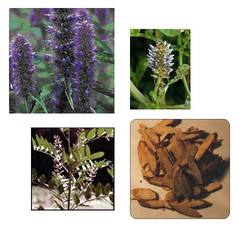Glycyrrhiza Glabra (muleti/yashti Madhu, Liquorice, Sweet Wood)

Biological Name:
Glycyzrrhiza glabra
Family:
Papilionaceae, Leguminosae
Other Names:
Sweetwood, Liquorice, Licorice root, Mithi-lakdi, Mulathee, Jethi-madh, Yashtimadhu, Yashtomadhu, Jashtimadhu, Yashtimadhukam, Athimadhuram, Atimadhuram, Erattimadhuram, Athimathurappal.
Habitat:
The plant can be met across the globe. Cultivated in Jammu and Kashmir, Punjab and Sub Himalayan tracts.
Additional Info:
- Rasa (taste) Sweet, bitter
- Vırya (energy) Cooling
- Vipaka (post-digestive effect) Sweet
- Guna (quality) Heavy, moist
- Dosa effect VPK−, K+ in excess
- Dhatu (tissue) Every tissue is affected
- Srotas (channel) Digestive, respiratory, nervous, excretory, reproductive
Ayurvedic Action
- Vrsya Sexual potentiser
- Sukrala Increases semen
- Jıvanıya Vitalising
- Rasayana Benefits all seven tissues
- Caksusya Benefits the eyes
- Vranaropan.a Heals ulcers and wounds
- Kanthya Benefits the throat
- Kasasvasahara Benefits coughs and breathing difficulties
- Medhya Benefits the nervous system
- Kandughna Eliminates itching
- Sonitasthapana Alleviates bleeding
- Pitta/vatahara Reduces pitta and vata
It is thought to harmonize the relations. It is madhur (sweet), slightly tikla (not much bitter), sheetala (sheetaveerya),: used in opthalmia, deranged pitta, anorexia, emaciation, allays thirst and cures ulcer.
It is Caksusya (benefits the eyes), Jıvanıya (vitalizing), Rasayana (benefits all seven tissues), Vranaropan (heals ulcers and wounds), Kanthya (benefits the throat) Kasasvasahara (benefits coughs and breathing difficulties), Medhya (benefits the nervous system), Kandughna (eliminates itching), Sonitasthapana (alleviates bleeding), Pitta/vatahara (reduces pitta and vata)
Elements Applied:
Dried root is commonly applied in herbal medicine.
Active Components:
- Triterpenoid saponins Glycyrrhizin
- Flavonoids Liquiritin, isoliquiritin
- Phytosterols Stigmasterol, β-sitosterol
- Coumarins
- Glycyrrhetinic acid
- Volatile oils Anethole, estragole, eugenol (Mills & Bone 2000)
Triterpenes belonging to oleanane type, mostly glycyrrhizin, as well as its glycyrrhitic acid (agylcone glycyrrhetinic acid), licoric acid, liquiritic acid, isoglabrolide, glycyrrhetol, phytosterols and glabrolide; Iisoflavonoids and flavonoids; kumatakenin, liquiritigenin, glyzarin, liquiritin, glabrone, rhamnoliquiritin, glabrol, neoliquiritin, formononetin, licoflavonol, licoisoflavanone, licoisoflavones A and B, and so on.
Coumarins; herniarin glycyrin, umbelliferone, liqcoumarin, Polysaccharides, mostly glucans, Chalcones; rhamnoisoliquiritin, echinatin, liquiritigenin, licochalcones A and B, isoliquiritigenin, licuraside, neosoliquiritin, and so on.
Volatile oil, which includes benzaldehyde, fenchone, furfuryl alcohol, and linalool. other; amino acid, sugars, starch, and so on.
History:
Licorice has been conventionally used in herbal medicine since time immemorial. According to contemporary researches, it is potent of stimulating liver, the endocrine system, and other organs. Licorice triterpenes are processed by the organism to form the substances, which are similar to adrenal cortex hormones in their constitution. Due to this reason it is applied for a range of inflammations.
Used For:
- It used in hyperacidity, and stomach aches and discomfort and other symptoms caused by acrid matter in the stomach.
- It improves liver functions, reduces spasms and pains.
- It is a gentle laxative thus relieves constipation.
- It has soothing fragrance.
- It is also very useful in sore throat, hoarseness of voice, coughs, colds, bronchitis and asthma as an expectorant.
- It is used as a demulcent in the inflammatory conditions of bronchial tubes and bowels.
- It strengthens the immune system. It modulates the immune system and has shown remarkable immuno-stimulant and antioxidant properties.
- As a tonic and refrigerant it rejuvenates the body and calms the nervous system.
- Licorice is useful in painful urination, ulcers, sore throat, muscle spasms, mucous membrane looseness, laryngitis, inflammation, heart weakness, general debility.
- Due to its anti-inflammatory properties, Licorice is used in arthritis.
- It cures irritable conditions of the mucus membrane, and strengthens the immune system and provides resistance in recurring infections.
- Due to its positive activity on the liver, the herb is applied for treating cirrhosis and recurrent hepatitis, for which aims it is popularly prescribed in Japan.
- The majority of licorice studies were based on triterpene glycyrrhizin research. The substance takes responsibility for decreasing hepatocyte disorder induced by PCB, hexachloride, benzene and tetrachloride. It improves antibody production by triggering interleukin secretion by the body.
- Glycyrrhizin decreases the development of RNA and DNA viruses, as well as Herpes simplex virus, which is completely destroyed due to its actions.
- The substance is widely applied in bronchial conditions like coughs, bronchitis, and catarrh.
- Licorice is applied as part of allopathy treatment for peptic ulcers, which is common to its application in gastric ulcer and gastritis. It may also be applied to relieve stomach colic.
- Licorice is a nutritional agent for brain, due to its ability to stimulate cerebrospinal and cranial fluid production. It enhances one’s eye sight, hair condition, and body complexion.
Safety:
1-4 masha (1-4 gm) per day can be taken safely (Bhavaprakasha Nighantu). Exercise care. Herbs in Ayurvedic medicine are commonly mixed with other herbal medicines to reduce the toxic effect one of them may produce on the body.
Contact Us
Govind Madhav Herbal Tea
B 29-30, Hari Nagar,, Delhi - 110064, India
Call Us : View Mobile Number
Phone : +91-11-45615006
E-mail : govindmadhavtea@gmail.com
